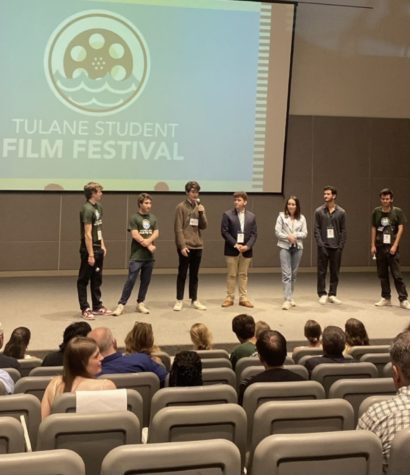Ode to the Tulane Student Film Festival
Before the second Tulane University Student Film Festival, students in the digital media practices coordinate majors asked what to wear in the major GroupMe chat. Many of the films came from their classrooms, either senior capstones or smaller assignments, like mini-documentaries or non-narrative montages. Students sent images of black and white ball gowns, joking about what they would wear to the event.
Some did dress up, clad in a knee-length dress or full suit, standing in front of the Step and Repeat on the red carpet leading up to Woldenberg Art Center.
Jolene Pinder, a documentary producer and Strategy, Leadership and Analytics Minor professor, huddled with student filmmakers and her students in matching green shirts. She runs the SLAM class that makes the Tulane Student Film Festival possible, helping students plan and curate the screenings while they collect donors and market it. Her students ushered people to their seats and clicked photos from the corner.
The festival started as a final project, providing a good resume-building activity and helping students learn the skills behind festival planning. However, after one year, the festival represents more than just a final project for SLAM 3914.
The digital media practices program fosters so much talent. Students in the program frequent the Caroline Richardson Building; they huddle together in the gray room, perfecting transitions, color grading and lamenting over set mishaps. Too frequently, students forget their films on hard drives, turn them in and set them aside after laboring over their films, passionate about their stories.
The festival provides the perfect community setting for filmmakers and film lovers. Pinder leaves the control up to the students and provides moments for them to shine, whether running Raising Cane’s themed giveaway prizes to a lucky audience member or leading the filmmaker panel in between screenings.

After the first year, Pinder and her students capitalized on the initial success and polished it. As audience members approached Woldenberg, the lobby transformed into a movie theater setting. The room held snowballs with brightly colored plastic bottles full of different syrups and offered delicious treats or crisp AHA sparkling waters. Alumni, students, professors and more carried their popcorn containers to the screening room. They walked past high-top tables with glossy programs and little packets of Starbursts beside Tulane-colored balloon centerpieces. Green-shirt students ushered the audience into the screening room, handing out pieces of paper to vote on the best short films and depositing them in bins, scraps of paper merging like confetti.
The curation team put love and time into the two screenings, showcasing 20 shorts altogether. The films ranged in genre, duration and theme, switching between a 15-minute karaoke-musical theater spin on West Side Story — featuring psychedelic graphics and an original score — to Oona, a masterfully edited micro-documentary exploring the female artist experience. Over the course of the evening, the audience lived in open fields beside kids in rubber fox masks, witnessed an intellectual montage exploring the fear of growing old and escaped a pizza serial killer. The audience collectively lived on a New Orleans front porch with a “Letter to Penny” and kicked out creepy first dates with “Your Loss.” The submissions pushed the boundaries of what students could accomplish, such as Mike Maloney’s “Billy Buckaroo,” which was the first animated capstone.
The Tulane Student Film Festival cultivates the best of student filmmakers, fostering passion and building anticipation of what Pinder and her students can accomplish next year.
Your donation will support the student journalists of Tulane University. Your contribution will allow us to purchase equipment and cover our annual website hosting costs.


